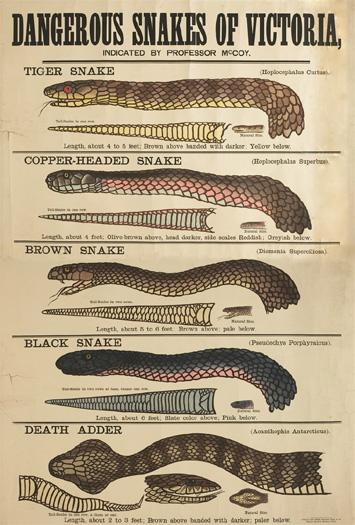|
| Query: common death adder | Result: 3rd of 9 | |
Bardick (Echiopsis curta), Lowlands copperhead (Austrelaps superbus), Eastern brown snake (Pseudonaja textilis), Red-bellied black snake (Pseudechis porphyriacus), Common death adder (Acanthophis antarcticus)
| Subject: | Bardick (Echiopsis curta), Lowlands copperhead (Austrelaps superbus), Eastern brown snake (Pseudonaja textilis), Red-bellied black snake (Pseudechis porphyriacus), Common death adder (Acanthophis antarcticus)
| | Poster: | Wiki Photos (---@---.---)
| |

| Resolution: 355x525
File Size: 48133 Bytes
Upload Date: 2018:09:21 11:25:07
|
English: Four legs good, no legs bad? Dogs, snakes, doctors and police in colonial Australia
Date 1877
Source https://www.flickr.com/photos/royalaustralianhistoricalsociety/12599853144/ (Dangerous Snakes of Victoria 1877- Museum Victoria collection)
Author Royal Australian Historical Society
Source: https://commons.wikimedia.org/wiki/File:Dangerous_Snakes_of_Victoria_1877-_Museum_Victoria_collection_(12599853144).jpg
TIGER SNAKE - Hoplocephalus curtus
The bardick (Echiopsis curta) is a species of snake in the family Elapidae. It is endemic to Australia.
The bardick is a heavy-bodied, venomous snake with a short tail and a broad head, clearly distinct from the neck.
COPPER-HEADED SNAKE - Hoplocephalus superbus
The lowland copperhead or lowlands copperhead (Austrelaps superbus) is a venomous snake species in the family Elapidae. It is commonly referred to as the copperhead, but is not closely related to the American copperhead, Agkistrodon contortrix. If provoked, the lowland copperhead is a dangerous snake with neurotoxic venom, which can kill an adult human if correct first aid is not applied promptly.
BROWN SNAKE - Diemenia superciliosa
The eastern brown snake (Pseudonaja textilis), often referred to as the common brown snake, is an extremely venomous snake of the family Elapidae, native to eastern and central Australia and southern New Guinea. Considered the world's second-most venomous land snake after the Inland Taipan and based on its LD50 value (subcutaneous) in mice, it is responsible for about 60% of snake-bite deaths in Australia.
BLACK SNAKE - Pseudechis porphyraicus
The red-bellied black snake (Pseudechis porphyriacus) is a species of elapid snake native to eastern Australia. Though its venom is capable of causing significant morbidity, a bite from it is not generally fatal and is less venomous than other Australian elapid snakes. It is common in woodlands, forests and swamplands of eastern Australia. It is one of Australia's best-known snakes, as it is common in urban areas along the eastern coast of Australia.
DEATH ADDER - Acanthophis antarcticus
The common death adder (Acanthophis antarcticus) is a species of death adder native to Australia. It is one of the most venomous land snakes in Australia and globally. While it remains widespread (unlike related species), it is facing increased threat from the ongoing Australian cane toad invasion. |
^o^
Animal Pictures Archive for smart phones
^o^
|
|